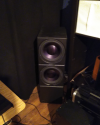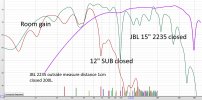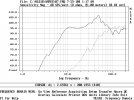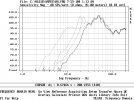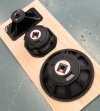My rooms longest dimension is 5 m. So that is way down from the 50Hz that seams ( see my measurement post #83) to be the gain start frequency. So then we do have a third gain variable after the Hz0 (Rene) and the Hz1 (Erin) described modes. This would then be the boundary gain witch in my case prowobly is the floor interaction with the 15in base driver.
Any thoughts about if this is right?
Too see correlation with your measurements, first go to
https://amcoustics.com/tools/amroc , enter your room dimensions and find the frequencies of the first two modes (1-0-0) and (0-1-0), also third (2-0-0), and fourth one (0-0-1).
These are the axial modes determined by your room dimensions, are two dimensional and particles in the close vicinity of these boundaries cannot move, resulting in lowest particle velocity but highest pressure. These modes are hard to miss, but it's excitation can be manipulated by position of your source(s) and your listening position, resulting in different peaks and nulls.
If your room is not leaky, then yes, f0 mode would give you flat response down to DC, but for a prediction of a normal, leaky room, try the WinISD Linkwitz filter where you enter your second (0-1-0) mode as f0, and your first (1-0-0) mode as fp, where the room gain should start to roll off. You may see that WinISD will still predict a lot of room gain governed by the peak at the second mode, with a slope shaped around the first mode. For my room, this prediction works even with all windows and doors open.

